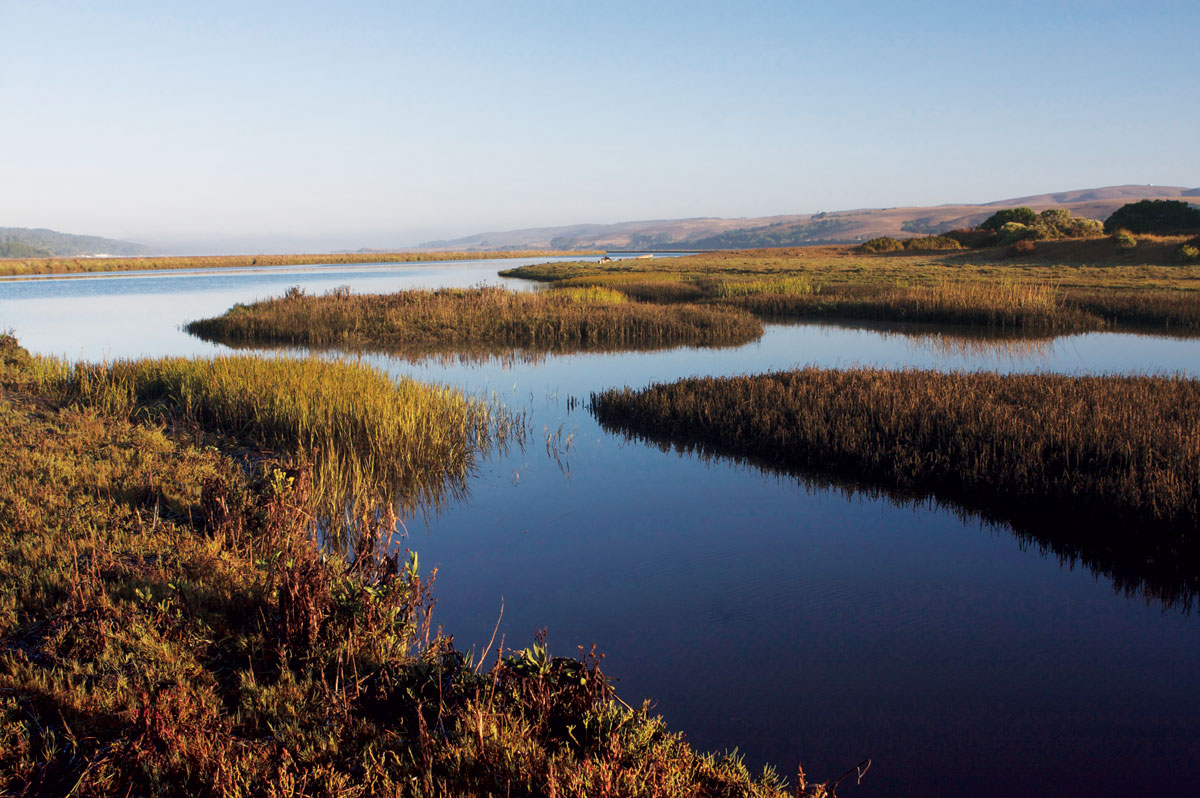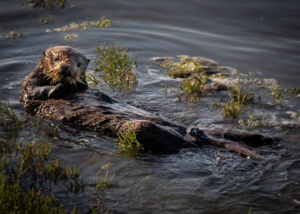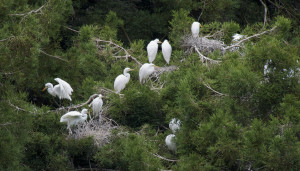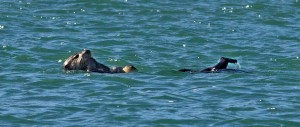Our three observation boats rarely break formation as we count waterbirds along the 12-mile survey route on Tomales Bay. That’s a lot of water to cover, and the effort requires intensive focus. Only when we encounter a rare or spectacular seabird, or a gray whale visiting from the outer coast, do we interrupt the count to relish the moment. So when veteran team member Jim White radios the other boats to announce “a couple of black scoters, male and female, coming your way!” field observers on our Audubon Canyon Ranch (ACR) Waterbird Survey team focus their attention, briefly, on the noteworthy pair of diving ducks. As the birds take flight at a low angle off the water with a broad sheet of several hundred surf scoters, cheers arise from the team members, who have been concerned about previous declines in both species. Could the large flock of scoters we’re seeing today be a sign of the changes on Tomales Bay? A growing body of evidence—including a tenfold increase in the number of dabbling ducks—points to a dramatic rebound of wildlife populations in Tomales Bay following restoration of its largest tidal wetland, at the southern end of the estuary.
As the Conservation Science Director at ACR, I’ve had the opportunity to collaborate with Jules Evens of Avocet Research Associates, to monitor both subtle and dramatic changes in wildlife use of habitats around the bay, for nearly three decades. But none of our observations has been as profound as the changes we have witnessed since tidal action was reintroduced into the Giacomini Wetlands seven years ago.
“The Giacomini Wetlands restoration is not only restoring the historic tidal marsh, it is restoring Tomales Bay itself.”
When the National Park Service finished removing the earthen levees in 2008, allowing tidal waters to inundate 550 acres of diked agricultural land for the first time in six decades, the goals were simple and powerful: restore the natural flow of water through the system, then stand back and let nature design the details. To achieve that, the historic marsh plain was reconnected to both the bay’s saltwater tides and the area’s freshwater creeks. The mixing and circulating of these waters through the marshland restores the fundamental processes needed to promote the natural recovery of the estuary. We hoped birds and other wildlife would move into the recovering wetland. But we also sought to understand the extent to which the restored wetland might enhance the rich patterns of life in the rest of Tomales Bay.
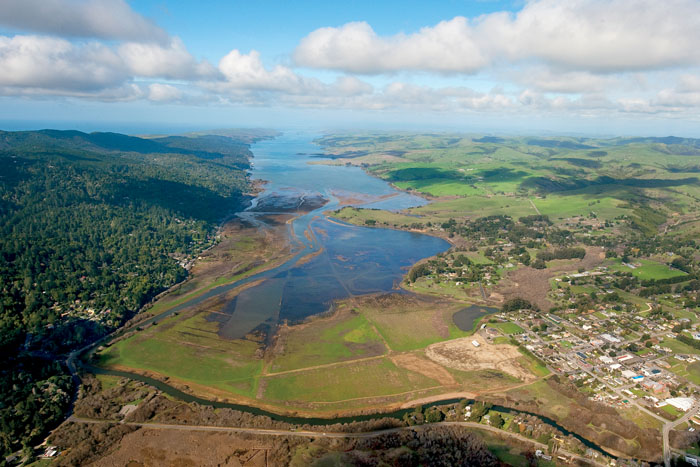
The recovery of the restoration site has quickly exceeded our expectations, and we now have evidence that the effort is profoundly benefiting the entire system. Point Reyes National Seashore wetlands ecologist Lorraine Parsons, the lead planner of the restoration project, puts it simply: “The Giacomini Wetlands restoration is not only restoring the historic tidal marsh, it is restoring Tomales Bay itself.”
The waters of Tomales Bay flood the northern 14.5 miles of the Olema Valley, formed by the San Andreas Fault along the central California coast, about 30 miles north of San Francisco. The bay is mostly subtidal, offering more waterbird habitat through the tidal cycle than most other Pacific coast estuaries do. Even before the restoration, the exceptional abundance of wintering and migrating shorebirds qualified Tomales Bay as a wetland of regional importance according to the Western Hemisphere Shorebird Reserve Network. The extraordinary value of Tomales Bay to shorebirds and other waterbirds (especially diving ducks) also led to its recognition as a “Wetland of International Importance” by the Ramsar Convention, a global intergovernmental treaty for the conservation of wetlands.
But bringing back the heart of the estuary—its largest tidal marsh and primary source of freshwater—has demonstrably enhanced Tomales Bay’s importance to birds and other wildlife. Set between the pastoral ranchlands of West Marin to the east and the protected wildlands of Point Reyes National Seashore on the western shore, Tomales Bay has long been recognized as one of the most intact and biologically healthy estuaries along the California coast, even prior to the restoration. As such, it has long served as an essential refueling site for migrating shorebirds and waterfowl along the Pacific Flyway as well as home for large numbers of overwintering and resident species. And now, by bringing back some 12 percent of the historic coastal wetlands between Cape Mendocino and Point Conception, the Giacomini Restoration project dramatically enhances the bay’s ecological value to those species.
For some 60 years, a critical piece of the estuarine system had been missing. The restoration of that missing piece stimulated the natural development of a complex habitat mosaic of shallow ponds, mudflats, emergent marshes, and tidal sloughs. The new range of habitat conditions provides a kaleidoscope of feeding and resting opportunities for resident and visiting wildlife through the tidal cycle. In addition, because these new conditions blend gradually into higher portions of the wetland landscape—well beyond the current reach of tides—they provide valuable space for the tidal marsh to adjust and shift in response to future sea level rise. We can get a picture of the impact of these new conditions by looking at some of the species that make use of the range of habitats now on offer in the bay.
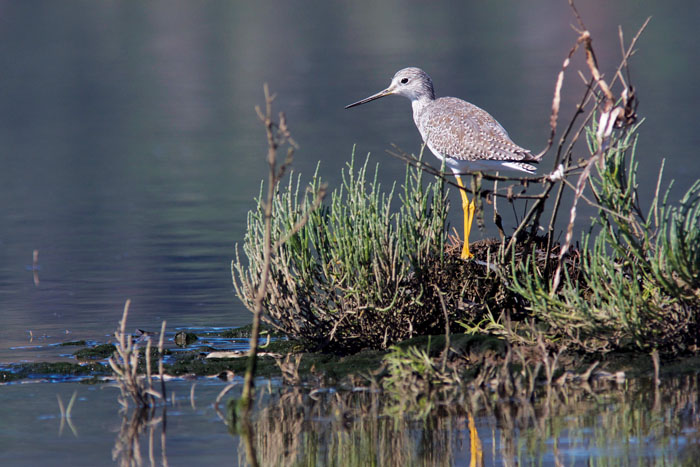
Renewed Abundance in the Restored Wetlands
The restoration experiment began on October 30, 2008, when the tide rushed in over the lowered levees that once protected the pastureland of the Giacomini Ranch. As the waters flowed in, a tight flock of a dozen or so dowitchers—chunky, medium-size shorebirds — flew in to investigate. Wheeling and twisting at high speed, the flock completed a long, low sweep over the incoming water, then settled at the tide’s edge. Their arrival seemed auspicious and exactly right, eliciting cheers from the crowd of restoration-day onlookers.
Each fall, upon arriving in California from nesting grounds in northern Alaska, short-billed and long-billed dowitchers seek such places—marshes, flooded agricultural lands, sand or mud-bottomed ponds, and the shallow edges of mudflats—to either spend the winter or refuel before continuing south. Long-billed dowitchers, in particular, soon began to frequent a portion of the restored wetlands that developed precisely into the kind of still, brackish shallows that they prefer. Foraging dowitchers often move with a mob-like intensity among shifting tidal conditions, using their stout bills to “stitch” through the mud, like a sewing machine, to find prey. Individuals will even submerge their heads underwater to probe into the soft bottom. Using special tactile receptors at the end of their bills, they detect burrowing crustaceans and other invertebrates buried in the mud.
The early presence of dowitchers was on the one hand unsurprising, as dowitchers often feed on a variety of larval insects and even earthworms that are present during the early stages of restoration. On the other hand, the increased presence of long-billed dowitchers within weeks of the tidal reintroduction hinted at the restoration’s broader impact on the birds inhabiting and visiting Tomales Bay. The inspiration and intent of restoration efforts are indeed often to provide expanded, regional benefits to wildlife. So we wondered if the restoration would stimulate growth in regional bird populations or if shorebirds from the more distant reaches of Tomales Bay were simply shifting their activities into the new wetland. Documenting such impacts can be difficult, but we were fortunate to have 25 years of Tomales Bay–wide shorebird monitoring observations, gathered before and after the restoration by birders working with Audubon Canyon Ranch, to guide our investigation.
Now, seven years after tidal reintroduction, it is clear that wintering shorebird populations in southern Tomales Bay have grown in response to the revitalized wetland. (Shorebird numbers in northern Tomales Bay have shown relatively little, if any, boost.) This growth of surrounding shorebird populations is far more important, ecologically, than the more easily observed rise in wildlife use of the restoration site. Unlike local shifts in wildlife visitation to particular areas of the landscape, population growth reveals an actual increase in the number of individuals that depend on Tomales Bay—and the capacity of the bay to support them.

As with dowitchers and other wintering shorebirds, the value of the restoration to least sandpipers—sparrow-size shorebirds with yellowish legs and strongly patterned brown backs—was strong enough to not only draw them to the new wetlands but also stimulate the growth of their surrounding population in Tomales Bay, fueling a broader “ecological release” that increased the overall number of birds. These tiniest of shorebirds travel in large flocks, which can be seen wheeling into the restoration area like puffs of silver smoke, stretching, expanding, and flattening in the wind, then landing and scattering, blending with the color of the tidal flats.
Weighing less than an ounce, leasts must feed more continuously than larger birds to balance their energy needs. But evolution has provided them with an unusual ability to hide in the vegetation while foraging and as a result take quick advantage of the new wetlands. They move, like other shorebirds, from location to location in the bay with the rhythms of tides, seasonal runoff, weather, and other conditions that affect their ability to find food.
Other small shorebirds, such as western sandpipers or dunlin, rely on open mudflats to forage while they protect themselves through a communal readiness to leap into tight, flashing flocks to confuse and elude predatory falcons. When foraging in mixed flocks, leasts also respond with this kind of evasive flight, but they have another strategy too, which apparently provided an immediate advantage as the tides began to circulate through the new wetland. Even before the former pasture transitioned into salt marsh vegetation of pickleweed and sea lavender, before polychaete worms, crustaceans, and other invertebrate prey developed beneath the surface of the developing tidal flats—and despite the dramatic spiking of predation pressure from raptors as tidal flooding packed meadow voles and other terrestrial prey into the upper edges of the new wetland—least sandpipers took cover beneath remnant pasture grasses while foraging for larval insects and other transitional prey on the hidden surfaces of the evolving marsh.
We had long suspected that the lost portions of the estuary held a kind of “magic” for yellowlegs.
Some bird populations in Tomales Bay have lingered for decades in low numbers, occupying marginal habitat around the bay until the restored circulation of water finally revitalized their preferred habitats across the estuary’s new landscape. Among these is the greater yellowlegs. We had long suspected that the lost portions of the estuary held a kind of “magic” for yellowlegs because these slender, elegant shorebirds could reliably be found in the marginal puddles and upper sloughs outside the diked pasture. Now that suitable shallow-water habitat has increased dramatically, yellowlegs frequently dot the flooded expanses of the restored marsh plain, each foraging independently with its high-stepping gait or breaking into a short sprint to pluck a small fish from the water. A remarkable 145 percent increase in the yellowlegs population of southern Tomales Bay confirms the spectacular benefits of the restoration for this species.
In addition to yellowlegs, other, more secretive marsh birds, such as American bitterns and state-listed California black rails, are also expanding from the marginal patches of habitat into the newly restored marshland. Local populations of endemic salt-marsh common yellowthroats and Bryant’s savannah sparrows are recovering from historic habitat loss as a range of estuarine conditions spreads across the new wetland.
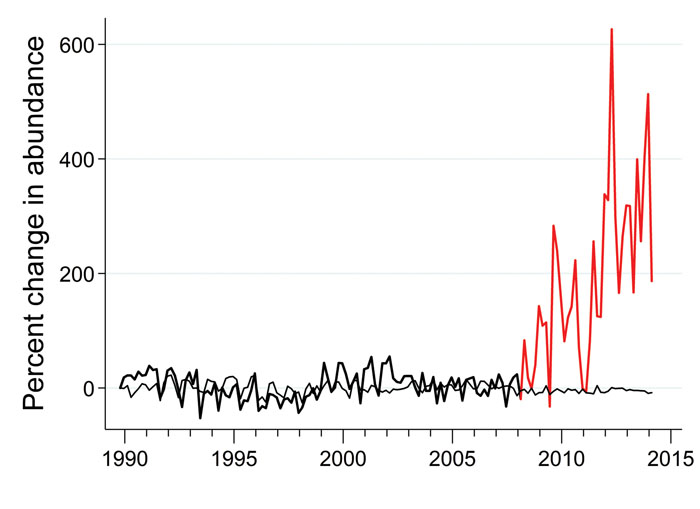
Moving Out into the Bay
While monitoring waterbirds from one of our survey boats, with binoculars pinned on the shoreline across a quarter-mile of bay, volunteer Roger Harshaw calls out, “Green-winged teal flock…22!” Prior to restoration, these small dabbling ducks occurred consistently but only in small, scattered numbers around the margins of Tomales Bay, and their abundance had been gradually declining for decades. Now, they too are staging an impressive comeback in the restoration area, with incursions that are spilling into the larger bay.
As soon as the tides flowed back into the historic wetlands, surface-feeding ducks (“dabblers”) such as green-winged teal arrived to check out the newly flooded ponds. During that first winter in 2009, numbers peaked at about 3,000 ducks—wigeon, shoveler, gadwall, pintail, and teal. Those calculations nearly doubled each subsequent year, with over 10,000 birds counted in 2012. The consistently huge early-winter abundances of dabblers indicate that Tomales Bay is providing important new support for wintering duck populations—and their dramatic late-winter declines indicate that the bay is supporting wide-ranging populations of these birds over a large area that extends beyond Tomales Bay—as these same birds move off to other, seasonally available feeding areas with increasing winter rains.

So far, we have observed 90 waterbird species and 13 species of raptors visiting the new wetlands. The dowitchers, least sandpipers, and ducks exhibit particular responses to the restoration, but species respond in numerous other ways, expanding the overall scope of avian activity in Tomales Bay. Western grebes and red-throated loons venture far from their preferred haunts in the deepest waters of Tomales Bay to pursue small fish in the developing tidal sloughs, which offer a different kind of subtidal habitat. Other species, such as great egrets and white pelicans, have established stable groups that feed primarily in the restoration site, leaving only occasionally to take advantage of alternative feeding areas elsewhere in the bay.
Dramatic fluctuations in habitat conditions caused by natural “disturbance” events—a key ecological feature of the Giacomini Wetlands—spur dynamic changes in bird use that further highlight connections with the rest of Tomales Bay. For example, when heavy storm runoff from Lagunitas Creek scours sloughs and marshes, dropping new layers of silt and debris over the tidal flats, many species— diving ducks and other waterbirds—move out into the larger bay, away from the dense, muddy plumes of storm water. Estuarine fishes swim bayward toward saltier, less turbid waters, some dispersing into nearshore coastal waters, while steelhead and salmon head upstream.

Eelgrass Meadows: An Ecological Keystone
For more than 60 years, the diked lower reach of Lagunitas Creek delivered heavy pulses of winter storm water, depositing excessive loads of suspended sediment and nutrients from the upper parts of the watershed directly into the bay. Since removal of the Giacomini levees, runoff from the creek once again flows over an open marsh plain and gets filtered through the marshland. Complex ecological processes have realigned, and hydrologic connections through the tidal marsh have been repaired, nourishing substrates and stimulating the productivity of the system. As life proliferates in the marsh, bayward elements of the system are buffered from abrupt changes in water quality.
Improving the quality of water entering the bay is helping to nurture the vast subtidal meadows of eelgrass. These underwater meadows provide essential habitat for waterbirds, fish, crabs, marine snails, amphipods, nudibranchs, anemones, and numerous other members of the estuarine community. The rooted vascular eelgrass plants thrive in the rhythmic balance between freshwater runoff and saline tides, photosynthesizing and breathing life into the bay, accounting for a major portion of the biological energy that sustains the estuarine system. Myriad invertebrates graze on the algal epiphytes that grow on eelgrass blades. Eelgrass meadows simply teem with life.
Recognizing a global decline of eelgrass meadows and their essential ecological role in estuaries, the National Oceanic and Atmospheric Administration (NOAA) has designated eelgrass as a priority habitat for conservation in California. The Giacomini Wetlands restoration was specifically designed to prevent or lessen this decline in Tomales Bay, and the prospects for success are encouraging.
Nearly a thousand acres of eelgrass meander along the length of Tomales Bay, mostly at depths within two meters of average daily low tides. To remain healthy and photosynthesize effectively, these subtidal meadows need a good amount of light to filter through the bay water. Excessive loads of suspended sediment can darken the waters until they appear virtually opaque. Similarly, excessive nutrients stimulate thick blooms of phytoplankton that render the water’s clarity into something like “pea soup.” The improved quality of water entering the bay through the new wetlands will help ensure the growth and protection of eelgrass, despite predicted increases in the intensity of future stormwater runoff from the watershed.
However, restoring water quality is a gradual process. Turbidity downstream of the restoration site actually increased initially an expected response to the tides reworking barren soils—but far less than predicted, and the murkiness has since decreased noticeably. Other aspects of water quality are improving faster than anticipated, and they are expected to continue improving for many years.
Of the many species that thrive on the eelgrass beds of Tomales Bay, perhaps the most noticeable is the black brant, a small sea goose that spends its summers in arctic breeding areas. Magnificent clouds of wintering and migrating brant, often numbering in the thousands, lift into dense aerial laceworks above their eelgrass feeding areas. These are truly specialized grazers that rely almost entirely on eelgrass. Although numerous other plants and animals grow on the eelgrass blades, the dietary requirements of brant are focused specifically on the vegetation.
Pacific herring also rely on eelgrass habitat. Each winter, tens of millions of these small schooling fish enter Tomales Bay from coastal waters, depositing vast quantities of roe, up to a kilogram per square meter of eelgrass. These spawning events act as powerful magnets, pulling in hungry species from all parts of the bay and nearshore coastal waters, including dense gatherings of resident harbor seals, which surface, roll, and dive over each school of herring. The sticky masses of herring eggs also provide critical sustenance for fishes, crabs, and nearly all species of waterbirds.
Eelgrass meadows also shelter and feed juvenile salmon, which move into the bay after surviving a considerable gamut of water-quality threats in the upper watershed. When young salmon, called parr, develop into more salt-tolerant smolts, they migrate down from freshwater streams to seek critical food and protection in the estuarine sloughs of the tidal marsh. As they continue to develop and mature, they move into the safety of eelgrass beds to feed on tiny invertebrates and continue adjusting to higher salinities before heading out into the ocean for the next stage of their anadromous lives.
The California bat ray is another underwater denizen of the bay’s eelgrass meadows, but it can frequently be seen when its “wing tips” break the surface of the water while it is cruising along the shallower regions of the bay. As bat rays wander through the eelgrass maze, the up-and-down movement of their wings creates a suction used to excavate invertebrate prey from the soft bay bottom. They are, in effect, tilling the substrate and oxygenating the sediments. Bat ray numbers may exceed several thousand throughout the bay. In summer, they use the eelgrass beds as nurseries, giving live birth to small replicas of themselves.

Restoring the natural flow of water between land and sea is fundamental to the health and living systems of Tomales Bay—from the rich pulses of marine life produced in eelgrass meadows during summer to the tiny creatures that live in and under the mud to the fishes, birds, and mammals and the habitats on which they depend. But the full effects of the restoration, and its likely benefits to Tomales Bay, are yet to be seen, because the seasonal dynamics of the estuary have been uncommonly moderate and mild since the project began. Extreme storm events are a key aspect of this system but remain essentially unobserved.
How dramatically will storms accelerate the development of tidal sloughs, resculpting the marshland into a more elaborate system of tidal circulation? To what extent will thick deposits of sediment from extreme flooding events lift and nourish the newly formed marsh? And how resilient to winter storms will the expanded populations of estuarine invertebrates and shorebirds prove to be? We obviously don’t know the answers, but we feel privileged to have a ringside seat to observe the unfolding drama of nature reasserting itself across Tomales Bay. In the years and decades ahead, we look forward to seeing just how life adjusts to changing conditions in a fully functioning estuary.

